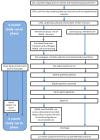Evaluation of the impact of the GRACE risk score on the management and outcome of patients hospitalised with non-ST elevation acute coronary syndrome in the UK: protocol of the UKGRIS cluster-randomised registry-based trial
- PMID: 31492797
- PMCID: PMC6731819
- DOI: 10.1136/bmjopen-2019-032165
Evaluation of the impact of the GRACE risk score on the management and outcome of patients hospitalised with non-ST elevation acute coronary syndrome in the UK: protocol of the UKGRIS cluster-randomised registry-based trial
Abstract
Introduction: For non-ST-segment elevation acute coronary syndrome (NSTEACS) there is a gap between the use of class I guideline recommended therapies and clinical practice. The Global Registry of Acute Coronary Events (GRACE) risk score is recommended in international guidelines for the risk stratification of NSTEACS, but its impact on adherence to guideline-indicated treatments and reducing adverse clinical outcomes is unknown. The objective of the UK GRACE Risk Score Intervention Study (UKGRIS) trial is to assess the effectiveness of the GRACE risk score tool and associated treatment recommendations on the use of guideline-indicated care and clinical outcomes.
Methods and analysis: The UKGRIS, a parallel-group cluster randomised registry-based controlled trial, will allocate hospitals in a 1:1 ratio to manage NSTEACS by standard care or according to the GRACE risk score and associated international guidelines. UKGRIS will recruit a minimum of 3000 patients from at least 30 English National Health Service hospitals and collect healthcare data from national electronic health records. The co-primary endpoints are the use of guideline-indicated therapies, and the composite of cardiovascular death, non-fatal myocardial infarction, new onset heart failure hospitalisation or cardiovascular readmission at 12 months. Secondary endpoints include duration of inpatient hospital stay over 12 months, EQ-5D-5L responses and utilities, unscheduled revascularisation and the components of the composite endpoint over 12 months follow-up.
Ethics and dissemination: The study has ethical approval (North East - Tyne & Wear South Research Ethics Committee reference: 14/NE/1180). Findings will be announced at relevant conferences and published in peer-reviewed journals in line with the funder's open access policy.
Trial registration number: ISRCTN29731761; Pre-results.
Keywords: acute coronary syndrome; cluster randomised trial; grace; guideline-indicated treatment; nsteacs; risk stratification.
© Author(s) (or their employer(s)) 2019. Re-use permitted under CC BY. Published by BMJ.
Conflict of interest statement
Competing interests: None declared.
Figures



References
-
- Jneid H, Anderson JL, Wright RS, et al. . 2012 ACCF/AHA Focused Update of the Guideline for the Management of Patients With Unstable Angina/Non–ST-Elevation Myocardial Infarction (Updating the 2007 Guideline and Replacing the 2011 Focused Update). A Report of the American College of Cardiology Foundation/American Heart Association Task Force on Practice Guidelines 2012;126:875–910. - PubMed
-
- Steg PG, James SK, Atar D, et al. . ESC Guidelines for the management of acute myocardial infarction in patients presenting with ST-segment elevation. The Task Force on the management of ST-segment elevation acute myocardial infarction of the European Society of Cardiology 2012;33:2569–619. - PubMed
-
- SIGN. Acute coronary syndromes: a national clinical guideline. (93). Edinburgh, UK: Scottish Intercollegiate Guidelines Network, 2007.
-
- NICE. Unstable angina and NSTEMI: the early management of unstable angina and non ST-segment-elevation myocardial infarction. (Clinical Guideline 94), 2010. - PubMed
Publication types
MeSH terms
Associated data
Grants and funding
LinkOut - more resources
Full Text Sources
Molecular Biology Databases
Miscellaneous
